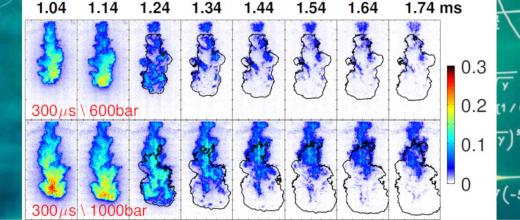09.12.2020
2 minutes of reading
An energy transition solution, hybrid propulsion systems will support greenhouse gas emission reduction objectives, pending the emergence of alternative mature solutions to further reduce the carbon footprint of road transport. In this context, the partners of the ANR’s ECN France project set out to improve the efficiency of existing combustion systems. They spent 4 years working together to try and gain a better understanding of the physical phenomena at play in engine combustion chambers. The principal methods deployed and the key results obtained are now available in the OGST journal.
Numerical models to improve the efficiency of IC engines
The transport sector is one of the biggest emitters of greenhouse gases. In addition to the development of electric vehicles, current projections all highlight the significant market shares that hybrid powertrain groups will continue to command in the coming decades when it comes to private vehicles. Also, given the specific nature of road transport constraints, it appears that while waiting for the arrival of disruptive technologies, heavy trucks will continue to be powered by IC engines for several decades to come. Accordingly, it is essential to improve the efficiency of IC engines, a technology that moreover represents a relatively risk-free route towards the energy transition.
The performances of IC engines have improved substantially in terms of thermal efficiency, thereby contributing to a significant reduction in CO2 levels and exhaust gas emissions. The numerical simulation of these engines, based on Computational Fluid Dynamics (CFD), is a powerful tool supporting combustion system efficiency, providing it accurately reproduces the physical mechanisms at play.
Progressing with the help of advanced optical diagnostics
Specifically, models used recently to make these predictions demonstrated that they could be further optimized. Accordingly, in order to make the required progress, engine research is aimed at gaining a better understanding of the physical phenomena occuring in combustion chambers.
The characterization of these phenomena depends on the development and application of advanced optical diagnostics capable of measuring in situ physical parameters during injection and combustion. These experimental data are necessary for the development of more accurate prediction models.
The contributions of the ECN France project
Co-Founded by Sandia National Laboratory (USA) and IFPEN in 2008, the ECN (Engine Combustion Network) contributes to this research via the production and sharing of new knowledge for the development of experimental and modeling activities. Between 2014 and 2019, the ECN France project, coordinated by IFPEN, brought together French research laboratories specializing in engine combustion studies.
Its objective: to promote the participation of the French engine combustion laboratory community in the international ECN and develop innovative diagnostics for the understanding of the physical phenomena in engine combustion chambers.
The ECN France special edition, published in 2020 in the OGST journal and containing 5 multi-partner articles, presents the project results. These cover a broad range of topics: from issues relating to experimental reproducibility to the development of advanced solutions for optical diagnostics.
>> Access the special edition







